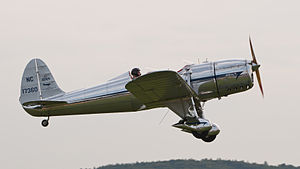Ryan ST
| Ryan ST series | |
|---|---|
 |
|
| A restored Ryan ST-A Special | |
| Role | Monoplane Trainer |
| Manufacturer | Ryan Aeronautical Company |
| Designer | T. Claude Ryan |
| First flight | 8 June 1934 |
| Introduction | 1934 |
| Status | still active |
| Primary users |
United States Army Air Forces Netherlands East Indies Army and Navy Royal Australian Air Force |
| Number built | 1,568 |
| Variants | Ryan PT-22 Recruit |
The Ryan STs were a series of two seat, low-wing monoplane aircraft built by the Ryan Aeronautical Company. They were used as sport aircraft, as well as trainers by flying schools and the military of several countries.
T. Claude Ryan was the founder of the Ryan Aeronautical Company, the second incarnation of a company with this name, and the fourth company with which he had been involved to bear his name (the first, Ryan Airlines, was the manufacturer of the Ryan NYP, more famously known as the Spirit of St. Louis). He began the development of the ST (for "Sport Trainer", and also known as S-T), the first design of the company, in 1933.
The ST featured two open cockpits in tandem in a metal semi-monocoque fuselage of two main frames - one steel, the other half of steel and half of aluminium alloy (alclad) - to take the loads from the wing spars and six more alclad frames; and alclad skin. It had wings in three sections of hybrid construction; the center section integral with the fuselage had tubular steel spars, the front spar a simple tube with an external brace to the upper fuselage, and the rear spar in the form of a parallel chord truss. The two outer wing panels had wooden spars and alclad ribs, with diagonal rods bracing the wings internally. Alclad sheet was used to form the leading edges, and fabric covered the whole structure. When attached, the outer wings were braced with flying wires to the fixed conventional landing gear and landing wires to the upper fuselage.
Five STs were built before the follow-on ST-A (A for Aerobatic) was developed with a more powerful engine. A single ST-B was produced, this being an ST-A with only one seat and an extra fuel tank where the front cockpit normally was; this aircraft was subsequently converted back to ST-A standard. The ST-A was further developed as the ST-A Special, with an engine of increased power.
...
Wikipedia
